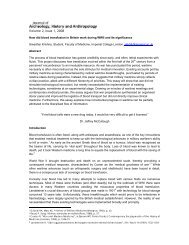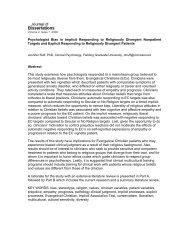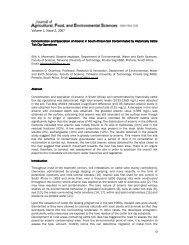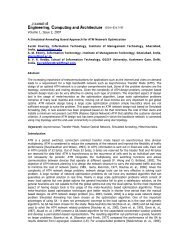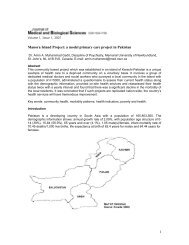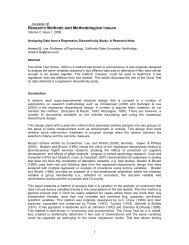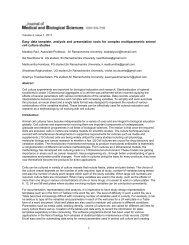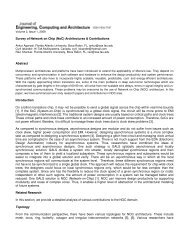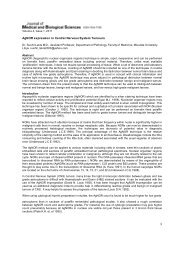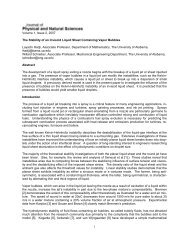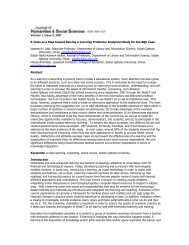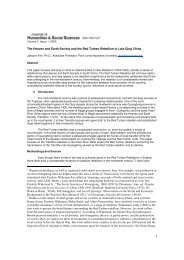Victims of circumstances - Scientific Journals International.
Victims of circumstances - Scientific Journals International.
Victims of circumstances - Scientific Journals International.
Create successful ePaper yourself
Turn your PDF publications into a flip-book with our unique Google optimized e-Paper software.
Volume 2, Issue 1, 2011<br />
1<br />
<strong>Victims</strong> <strong>of</strong> Circumstances<br />
<strong>Victims</strong> <strong>of</strong> <strong>circumstances</strong>: A case study <strong>of</strong> people living on the streets <strong>of</strong> a red-light area in<br />
Mumbai, India<br />
Sharvari Karandikar, PhD. Assistant Pr<strong>of</strong>essor, College <strong>of</strong> Social Work, The Ohio State University karandikarchheda.1@osu.edu<br />
Abstract<br />
This article is a case study <strong>of</strong> people living on the streets <strong>of</strong> Kamathipura, Asia’s largest red-light area located in<br />
Mumbai, India. It includes narratives <strong>of</strong> two female sex workers and two male intimate partners <strong>of</strong> sex workers from<br />
Kamathipura. In-depth interviews were conducted with each <strong>of</strong> these respondents for a period <strong>of</strong> two months. Each<br />
interview was written as a detailed narrative. The narratives were analyzed through a gendered lens, and<br />
comparisons between females and males were drawn on the basis <strong>of</strong> the social, economic, political, and legal context<br />
<strong>of</strong> Kamathipura. Analyses <strong>of</strong> the four narratives indicated economic, social, political and legal vulnerabilities <strong>of</strong><br />
females and males in Kamathipura. In the broader societal context, both males and females were identified as<br />
victims in their own right. However, analysis <strong>of</strong> their interpersonal relations from a gendered lens indicated additional<br />
victimization <strong>of</strong> females. The article also provides recommendations for practice, policy and future research in the<br />
area.<br />
Key words: Sex work, India, Violence, Case Study approach<br />
Introduction<br />
The present paper is a case study <strong>of</strong> people living on the streets <strong>of</strong> Kamathipura, Asia’s largest red-light<br />
area located in Mumbai, India. In this paper I present narratives <strong>of</strong> two female sex workers and two male intimate<br />
partners <strong>of</strong> sex workers from Kamathipura. (The men are not the partners <strong>of</strong> the women participants.) The narratives<br />
are analyzed through a gendered lens and comparisons between females and males are drawn on the basis <strong>of</strong> the<br />
existing social, economic, political and legal context <strong>of</strong> Kamathipura.<br />
Kamathipura was established by the British for the entertainment <strong>of</strong> their troops in the early 1800s. After the<br />
British left India in 1947, the red-light area was taken over by local brothel-keepers and sex workers. Over the years<br />
Kamathipura expanded and is now considered to be a necessary social evil (Menen, 2007). Located in the heart <strong>of</strong><br />
the city <strong>of</strong> Mumbai, it is populated by about 5,000 sex workers, male, female and transgender, either brothel-based or<br />
street-based (Megha, personal communication, May 10, 2007). Kamathipura is also one <strong>of</strong> the most rundown areas<br />
in the city <strong>of</strong> Mumbai. There are thirteen lanes in Kamathipura and each lane is crowded with small huts, tea-stalls,<br />
shops, lodges, pawnshops, eating-joints and brothels. The brothels have tiny rooms separated from one another by<br />
thin curtains. The brothel rooms are rented out to sex workers on an hourly basis. These rooms are cheap; it costs<br />
anywhere from 20 to 100 Rupees (Rs.) (approximately 2 U.S. dollars) to use the rooms. More than 40% <strong>of</strong> sex<br />
workers in Kamathipura are homeless (Menen, 2007). They live on the streets, on the footpaths and pavements.<br />
Their belongings fit in a small plastic bag which they carry with them everywhere they go. At night, they stand on the<br />
same street and solicit sex. When they get clients, they rent a brothel-room for some time and pay a share <strong>of</strong> their<br />
earnings to the brothel-keeper. Apart from sex workers, female and male brothel-keepers, pimps, clients and<br />
husbands and partners <strong>of</strong> sex workers are also seen on the streets <strong>of</strong> Kamathipura. Sex work is the primary business<br />
in the area and an income-generating option to those directly and indirectly involved in it. From sex workers, brothelowners,<br />
shopkeepers, restaurants owners, hotels/ bar owners to pimps, clients and the police, sex work is a<br />
moneymaking business. Even though sex work is illegal in India, it contributes to the national and international<br />
economy <strong>of</strong> the country (Fredrick, 2007, and Lim, 1998). The government authorities do not talk about improving the<br />
life <strong>of</strong> sex workers in Kamathipura because if they do, they are being supportive <strong>of</strong> an “illegal and immoral<br />
pr<strong>of</strong>ession.”<br />
A majority <strong>of</strong> the residents <strong>of</strong> Kamathipura are migrants from other states <strong>of</strong> India and from neighboring<br />
countries such as Nepal and Bangladesh. Once introduced to the sex industry, they do not return to their native<br />
places (Fredrick, 2000). Almost 90% <strong>of</strong> the people living in Kamathipura have some sexually transmitted infection at<br />
any given point in time (Gangoli, 2006) and 70% are estimated to be HIV positive (Menen, 2007). The people living in<br />
Kamathipura belong to the low socioeconomic strata <strong>of</strong> Indian society. They are below the poverty line and cannot<br />
afford to live in any other location in the city. Kamathipura provides them with cheap accommodation, food, drinks<br />
and drugs. There are numerous dance bars, movie halls and gambling joints in the area for entertainment. People<br />
know each other and any newcomer is welcome provided he or she is willing to live in isolation to the outside world.
2<br />
<strong>Victims</strong> <strong>of</strong> Circumstances<br />
No one ever protests against the deplorable situation <strong>of</strong> the area. If any government authority takes interest in the<br />
area, their business will be ruined, sex workers will be arrested and thousands <strong>of</strong> people in the area will be jobless<br />
and hungry (Menen, 2007). People in Kamathipura therefore live in silence and accept their clandestine existence.<br />
People here are infamous in the outside world and do not belong to the glitter and glory <strong>of</strong> Mumbai city. Their<br />
existence is confined to the margins <strong>of</strong> the society, to the thirteen lanes <strong>of</strong> Kamathipura. The anonymity <strong>of</strong> these<br />
lanes helps them forget their unfortunate past. No matter how harsh and dangerous it is, they all live here, finding<br />
acceptance in the apathy <strong>of</strong> Kamathipura. Their dignity, which is <strong>of</strong>ten questioned by the outside world, is not<br />
contested in Kamathipura. It is safe amidst its dangers!<br />
Prior research on Kamathipura<br />
Kamathipura is widely covered by the print and television media. There are several newspaper articles,<br />
movies and films on Kamathipura. Even a simple Internet search <strong>of</strong> the word ”Kamathipura” brings up articles,<br />
photographs and movie clippings about the red-light area. Though information from these sources is easily available,<br />
it is not substantiated by research and some <strong>of</strong> these sources tend to sensationalize the area by providing graphic<br />
images <strong>of</strong> sex workers and dance girls. An additional source <strong>of</strong> information about Kamathipura is the reports and<br />
documents <strong>of</strong> non-pr<strong>of</strong>it organizations working in the area. Most <strong>of</strong> these organizations work on improving health<br />
conditions and reducing HIV/AIDS among women and children. The organizations’ reports highlight the pr<strong>of</strong>ile <strong>of</strong><br />
women and children in the area and provide assessments <strong>of</strong> their health status. Though these reports are factual,<br />
they are not based on scientific research but rather on the organizations’ goals and objectives. Apart from this there is<br />
very little published research available on this area.<br />
Early research on women in Kamathipura was conducted by Punekar and Rao in 1962. This research<br />
studied the demographic pr<strong>of</strong>ile <strong>of</strong> sex workers in the area and reported that the majority <strong>of</strong> sex workers were<br />
trafficked as minors into Kamathipura from rural areas <strong>of</strong> India, Nepal and Bangladesh. The study also reported that<br />
sex workers lived in unhygienic physical conditions in Kamathipura and were <strong>of</strong>ten subjected to illness due to poor<br />
nutrition and medical care.<br />
Since then there have been a few references to Kamathipura in peer-reviewed articles (Misra et. al, 2000;<br />
Singh & Kapur, 2001; Gangoli, 2002; Tambe, 2005). However, none <strong>of</strong> these articles were based on research studies<br />
conducted in Kamathipura. In recent times, Karandikar & Prospero, 2008, conducted research on the sex workers <strong>of</strong><br />
Kamathipura. This study indicated similar findings to the study done by Punekar and Rao in 1962. Sex workers<br />
reported to be migrants and were trafficked from rural areas. They described living in poor and unhygienic physical<br />
conditions and complained <strong>of</strong> several health risks, including the risk <strong>of</strong> HIV infection. Apart from this, the research<br />
also highlighted a high prevalence <strong>of</strong> violence and victimization <strong>of</strong> female sex workers from male intimate partners,<br />
pimps and clients.<br />
Methods and Purpose <strong>of</strong> the present study:<br />
The author recently conducted a study in Kamathipura to understand the violence against female sex<br />
workers in the area. In all, 60 respondents were interviewed for this study. These respondents included female sex<br />
workers, male intimate partners, clients <strong>of</strong> sex workers, pimps, social workers, brothel-keepers and police <strong>of</strong>ficers.<br />
From this pool <strong>of</strong> 60 respondents, the author selected four respondents, two female sex workers and two male<br />
intimate partners, and conducted in-depth interviews with them to understand their life and hardships in the context <strong>of</strong><br />
Kamathipura. These interviews were conducted over a period <strong>of</strong> two months. Each interview session lasted for<br />
approximately one hour and each respondent was interviewed for four sessions. The interviews were open-ended<br />
and the respondents were asked to narrate their life stories. All the interviews were conducted in Hindi, a local Indian<br />
language, and were audio-taped. For the purpose <strong>of</strong> analysis, each interview was transcribed and translated back<br />
into English. Each interview was written in the form <strong>of</strong> a narrative.<br />
In the following section the author presents four narratives. These narratives capture, in essence, the<br />
structural poverty and victimization explained by the respondents. While each narrative speaks for itself, the reader<br />
cannot help but notice similar themes across the four narratives. The purpose <strong>of</strong> the paper is 1) to explore similarities<br />
between respondents in the existing social, economic, political and legal context <strong>of</strong> Kamathipura, and 2) to analyze<br />
these realities in the light <strong>of</strong> gender. Males and females had several similar experiences <strong>of</strong> poverty and disparity.<br />
However, when gender is used as a lens for analysis, women seemed more vulnerable compared with men.<br />
The narratives:<br />
The narratives presented below tell the story <strong>of</strong> men and women residing in Kamathipura. Ratna and<br />
Manisha are female sex workers in the area. Aslam and Ramesh identify themselves as intimate partners <strong>of</strong> sex<br />
workers. The narratives are in the respondents’ own language with its crudeness and colloquialism. Modification to<br />
make the sentences grammatically correct was deliberately avoided.
Ratna<br />
3<br />
<strong>Victims</strong> <strong>of</strong> Circumstances<br />
I am a sex worker for the past 19 or may be 20 years. I am not sure. My mother died during my birth and<br />
when I was 3 months old, my father passed away. I lived with my two older sisters in a small village on the<br />
Maharashtra-Karnataka border and worked in a field. None <strong>of</strong> us sisters went to school. We never had enough to eat<br />
and had to work for very long hours on the field. We were poor and when you are poor everyone takes advantage <strong>of</strong><br />
you. I think I was around 11 yrs old, two months after my first menstrual period, one evening as I was on my way<br />
back home my landowner’s son called out to me. He was with three other men. They started taking <strong>of</strong>f my saree and<br />
even before I could say or do anything they had started molesting me. That night I was gang raped in the farm in<br />
which I worked by the landowners son and his friends. I did not understand what was going on and did not even know<br />
how to fight back with those men. All that I remember now is that I was in pain. There was blood all over my saree<br />
and I was crying and shouting for help. No one came to my rescue. I went home the next morning and told my sisters<br />
about the incident. They were scared and advised not to tell anybody about what had happened. I was asked to keep<br />
quiet and forget about the incident. Though it was not possible for me to forget what had happened, I did not say<br />
anything with the fear <strong>of</strong> losing our wages. The next day when I went to the field I was asked to leave. I had lost my<br />
job. I decided not to go back home. I did not want to be a burden for my sisters. I was wandering in the village in<br />
search <strong>of</strong> a job and was determined to return home only after getting another job. After four days I met a man who<br />
promised me job in the big city (Mumbai). He sold me in brothel in Kamathipura for Rs. 20,000.<br />
Life here has also been so difficult. I married a man who was my client. He was a taxi driver but a lazy one.<br />
After we got married he left his job. He started “helping” me with clients but that was hardly any help. He would take<br />
away my money and force me to take clients. I had become his money-making machine. During my first pregnancy, I<br />
was detected HIV positive. I started taking help from organizations here but he never went to the doctor. He died a<br />
few years back. Now I am living with another man. He is worse. He beats me a lot. He is also a pimp and that too a<br />
famous one in the area. What bad luck! He follows me to the brothels and keeps track <strong>of</strong> my time. He drinks a lot,<br />
gets angry and beats me when I take slightly longer time with a particular client. He checks my underwear to see if I<br />
had sex with any man without his permission. I am nine months pregnant, this is my third baby but he thinks the child<br />
is not his. What can I say? He beats me all the time so I left the room. I live on the pavement now. All these men<br />
destroyed my life. Now I have HIV, they say even a drop <strong>of</strong> my blood can destroy someone’s life. How did I get so<br />
much power?<br />
We are not the real culprits. No sex worker should be blamed for HIV because if it was only sex workers how<br />
come the “good women” are dying too <strong>of</strong> AIDS too. It’s all because <strong>of</strong> the men who sleep with many women and they<br />
infect everyone. Men should be told about condoms not women because men have to use condoms not women!<br />
Women work hard but they are still arrested. The clients, pimps, our own husbands and even the police beat us. I<br />
don’t understand this. Why are we arrested? We are poor and hungry. We don’t have money to take a bath even.<br />
Why doesn’t anyone talk about all this? They don’t give us ration cards; we don’t get any services from the<br />
government. (The Indian Government uses ration cards to distribute subsidized food). Why are we so ignored? I don’t<br />
know! The police also take money from us. Every time to pay Rs 1200 fine is just impossible. I have taken loans to<br />
pay them and it’s on high interest. I don’t know what to do about this life.<br />
There is just one difference between you and me. I was born in a wrong family and you were born in a right<br />
family. If God had done the reverse, I would be interviewing you and you would be living my life as an orphan, a sex<br />
worker who was raped, widowed and detected HIV positive! Nothing worse can happen now.<br />
Manisha<br />
I am from Mumbai. My parents died in a road accident when I was eight years old. I have no siblings and I<br />
have always lived on the roadside. Even when my parents were alive we lived in pavements near Sandhurst Road<br />
(an area in South Mumbai) and after their death too I lived on the roads. I was introduced to sex work when I was 11<br />
years old by other girls in the vicinity. As I had no income and nothing to eat, I used to beg for money and food on the<br />
traffic signals. Some <strong>of</strong> my friends were earning very well in red-light areas and one <strong>of</strong> them asked me if I was<br />
interested. She took me to a gharwalli (brothel-owner) in Kamathipura and the gharwalli readily agreed to keep me.<br />
The gharwalli promised to give me food, clothes and a place to stay and told me that I would have to have sex with<br />
men in return and earn money. She told me that she would have a share in the money I earned but promised that the<br />
money will be more than sufficient for me to look after myself. I was only 11 years old at that time but I think I was<br />
more mature than my age. After living on the road for my entire life I was not scared <strong>of</strong> anything. Many men had tried<br />
to touch me when I was growing up. I was not raped but one night when I think I was around 10 years old, one man<br />
was trying to take <strong>of</strong>f my clothes. I could feel something on my body; I woke up and started screaming. The man was<br />
naked and was trying to undress me. I screamed with fright and my neighbors gathered and drove the man away.<br />
When the gharwalli made an <strong>of</strong>fer to me I thought about the decision to start sex work. I choose to get into the<br />
pr<strong>of</strong>ession and thought to myself that rather than getting raped on the roads I would at least get some money out <strong>of</strong><br />
the same work.<br />
I am here for 12 years. I married a man and we have six children, <strong>of</strong> which two are mine and four are from<br />
my admi’s (partner’s) first marriage. My admi’s name was Raja. He died a month ago. Raja was a drug addict and he
4<br />
<strong>Victims</strong> <strong>of</strong> Circumstances<br />
committed suicide. He was heavily drugged when this incident took place. Raja did not force me to do sex work but<br />
he suspected that I earned from sex work and followed me everywhere. He did not have any source <strong>of</strong> income and I<br />
started selling used electronic goods (second-hand) in the local market to earn and support our family. Raja would<br />
accompany me to work and kept an eye on my actions. I did not like his attitude and I was not used to any monitoring<br />
right from childhood. When I was with Raja I tried to stay away from sex work as much as possible. However, when I<br />
had nothing to eat and when Raja would be absolutely out <strong>of</strong> consciousness due to drugs and alcohol, I had to go for<br />
sex work in desperation. I did not tell him about it and tried to save that money with the social workers in the<br />
organization.<br />
On the day when Raja committed suicide we had a very big argument in the morning. Raja wanted some<br />
money to buy drugs and I refused to give him money. He got angry and as always started beating me up. This<br />
incident happened in front <strong>of</strong> our children. When Raja started beating me I tried to beat him back. He kicked me,<br />
pushed me on the ground and stood on my chest. He kicked my stomach and spit on me several times. He pulled my<br />
hair and dragged me on the road. I was scared, I was crying and screaming for help but everyone thought it’s just one<br />
<strong>of</strong> our regular fights and no one interfered. I escaped and took refuge at Prerana center (a drop-in center run by a<br />
social work organization). Raja thought that I had gone into sex work again and he started searching for me in the<br />
red-light area. He didn’t find me there and got angry. He poured a bottle <strong>of</strong> kerosene on his body and started shouting<br />
that if I don’t get out <strong>of</strong> my brothel he would burn himself. Just as he was going to light the matchstick, people from<br />
the neighborhood stopped him and took him to the police station. Some <strong>of</strong> my friends came to the Prerana center to<br />
call me. I went to the police station and spoke to the police <strong>of</strong>ficer. When Raja saw me at the police station he started<br />
verbally abusing me again the police got angry and started scolding him. Raja took <strong>of</strong>f the matchstick from his pocket<br />
and lit himself on fire. He ran outside the building into the police station compound and even though the police tried to<br />
save him, within no time he was unconscious. We tried to admit him to the hospital but Raja did not survive this<br />
accident.<br />
I don’t even know if I am sad about his death. After he passed away I was in a state <strong>of</strong> shock for almost five<br />
days. I was shocked not so much about his death but more about how he died. I saw it in front <strong>of</strong> my eyes. I saw how<br />
drugs had made him wild and even though I was angry at him I could not see him suffer.<br />
You should take a walk in the inner lanes the red-light area and corridors <strong>of</strong> brothel houses. You would see<br />
women lazing during the day time because they have worked and stayed awake for the whole night. Men are seen<br />
sitting outside on the corridors playing cards or smoking beedis (hand-made, low-cost roll <strong>of</strong> tobacco wrapped in dried<br />
leaves, an alternative to cigarettes). Some women would be cooking or dropping children <strong>of</strong>f to schools and day-care<br />
centers as men do not work in the red-light areas. If you look more closely you will see women crying over their ill<br />
fate. Some are beaten up and tortured, some are ill, some have bruises and swollen muscles but I think they are all<br />
scared to die and that’s why keep on living. There is no place for women. The police don’t protect us. They are our<br />
worst enemies. They drive us away and abuse and beat us like dogs. I have to borrow money from the moneylenders<br />
to give them [as bribe] for releasing me. They should protect us and our work should be recognized but what to do in<br />
a red-light area there is sadness all around. All men in red-light area depend on woman’s money and yet the woman<br />
is powerless.”<br />
Aslam<br />
I am 25 years old. I never attended school. I was born in Bihar (a state in north India), and our family was<br />
very poor. When I was 8 years old, my uncle brought me to Mumbai. I was taken to Dharavi (Asia’s largest slum<br />
district) and sold to a zari (embroidery) factory owner. Instead <strong>of</strong> a pencil to read and write, I was given a needle to<br />
work with. I was taught to embroider and stitch. I learned zari work as a child. I got some money and needed all <strong>of</strong> it<br />
to survive. Every day I was locked into the factory with other children so that we would not run away. We worked<br />
almost 14 hours every day.<br />
For 10 years I worked in the zari factory in Dharavi. Though I lived in Mumbai all along I had never left the<br />
Dharavi slum area. When I was 18, I decided to move out. Some friends brought me to Kamathipura. I had heard<br />
about the area and was fascinated about going to sex workers. But I never imagined that going to Kamathipura would<br />
be a one-way ticket for me.<br />
I started going to sex workers. In the first one week <strong>of</strong> living in Kamathipura’s brothels with different women,<br />
I was ripped <strong>of</strong>f my savings <strong>of</strong> Rs.1000. I had no money left. But the temptation was very bad. It was like lure; the<br />
women, the music, alcohol, hashish, I was so high. I was in trance and all this was new to me. I could beg, borrow or<br />
steal; I could do anything to live in pleasure. I decided to stay in Kamathipura. But the excitement was over in a few<br />
months. My reality was stark. I was poor, homeless, unemployed and uneducated. No woman would entertain me<br />
without money. I had gotten addicted and drugs and alcohol also required money. I started borrowing and there were<br />
debts. Life is not as easy as it should be. I found a job in a zari factory in Kamathipura. I still work there. But this is not<br />
such a big factory and the wages are very less. We are 10-11 <strong>of</strong> us and hardly make enough money to survive.<br />
I have been in this area for the past 6 years or so. I have managed to survive. I still have a good time. There<br />
are problems but this life is better than my life in Dharavi. I also have a woman now. I live with her. We have been<br />
together for two years and have two children. She was pregnant so we got married. I don’t think it is wrong. I am<br />
doing good work by accepting her. These women are so helpless. They are even more helpless than I was. I can
5<br />
<strong>Victims</strong> <strong>of</strong> Circumstances<br />
understand the reason why they come to sex work. Though I want her to stop, I can’t do anything. We depend on<br />
each other. Our children will be without food if she stops working. I dream <strong>of</strong> getting her out <strong>of</strong> the area. I am sure my<br />
dream will come true. I try to buy lottery tickets. Some day God will be kind and I will win lakhs <strong>of</strong> rupees just like that.<br />
Unless there is any miracle, I won’t be helped. All <strong>of</strong> us are victims <strong>of</strong> <strong>circumstances</strong>. Our poverty and desperation<br />
drives us to this area. Our family background is very bad. We have nothing and in that nothingness we all search for<br />
survival. When you don’t get food to eat you have to steal or solicit what’s the difference. The government does<br />
nothing for us. They have given up. So many people live here on the streets.<br />
What are you asking about violence? Violence among us is nothing compared to what the world has done to<br />
us. No I don’t beat her every day. I am very jealous <strong>of</strong> her clients. Why do they get so much <strong>of</strong> her time? She is busy<br />
at odd hours. I can’t have her when I want. These are my problems with her pr<strong>of</strong>ession. That’s why I don’t want her to<br />
be a sex worker. She gets beaten up but what can I do? We are poor and helpless. I have to allow her to work. She<br />
will stop if I tell her but I can’t tell her to stop. When I get enough money I will not let her work. I will treat her like a<br />
queen but not yet. Now she has to work. She is not doing wrong. This work should be legal. I will go for it! The police<br />
here need to be arrested. Sex work is not wrong. They also know that but they still arrest. They are so cruel. I hate<br />
them. They take bribes also. Go and talk to them and they will tell you.<br />
Author’s note: Aslam’s childhood resembles the reality <strong>of</strong> thousands <strong>of</strong> children in India who are trafficked<br />
for work into Mumbai. They work as child laborers under extremely difficult conditions. With barely enough food to<br />
survive most <strong>of</strong> their childhood is spent in learning embroidery work. The living condition <strong>of</strong> these laborers is<br />
deplorable. There is no access to safe drinking water, sanitation and even food is scarcely available. The finished<br />
goods are expensive designer clothes exported to foreign countries by rich factory owners. For the businesses that<br />
employ these children, the pr<strong>of</strong>its are enormous and the investment is bare minimum. Hence, child labor is another<br />
major social problem faced by India and other developing countries.<br />
Ramesh<br />
I was born here in Kamathipura in a local hospital. I am 25 years old. I have lived here for all my life. I have<br />
three brothers and one sister. My mother was a sex worker so we were all born and raised here. My mother was<br />
poor and she had to work and send money home. She was alone as our father abandoned her. She had to do sex<br />
work to feed us. As a child, I took help from different organizations in Kamathipura. I have attended day and nightcare<br />
shelters, boarding schools but nothing worked. They all tried to get me out <strong>of</strong> this area but I still live here. My<br />
mother tried to educate me but I studied only till 2 nd grade. I was never interested in studies. I spent my childhood on<br />
the streets <strong>of</strong> Kamathipura and I saw and heard all that they say children should not know about at a young age. I<br />
saw a lot <strong>of</strong> things, sex work, and the way they do business, how mother would be beaten up at times. I saw poverty<br />
and experienced hunger and a lot <strong>of</strong> frustration. My childhood was filled with such experiences. Now at 25, I hate this<br />
area but I still prefer to live here. Where else can I fit in?<br />
I have married a woman here who is also a sex worker and am taking care <strong>of</strong> her and her two children (from<br />
her previous marriage). I don’t work regularly but when I do I get Rs. 150 per day. Till six months ago I was a thief, a<br />
robber. I would steal money from clients or from anyone in the area. I would cut people’s bags or even picked<br />
pockets. However, I became a thief also because <strong>of</strong> the bad influence over me. It was not my fault. The<br />
<strong>circumstances</strong> made me a thief. Now that I don’t steal I can tell you openly who I was. I stopped stealing six months<br />
ago. I stopped because my wife brought her children here and in them I saw myself. If they see me doing bad things,<br />
they will also become like me. I don’t wish for anyone to have similar fate as mine.<br />
How I became a thief is also a story. When I was about 18, I fell in love with a minor girl. She was newly sold<br />
into Kamathipura. We were planning to elope and get married. The police got information that her brothel had a minor<br />
girl and so they conducted a raid in the brothel. When they conducted the raid, I was with her so they arrested both <strong>of</strong><br />
us. I told them that I was in love with the girl but they didn’t believe in me. They filed a false complaint <strong>of</strong> robbery in<br />
my name and called me a thief. After getting out <strong>of</strong> the jail I was so angry. I started stealing and actually became a<br />
thief. Now the police here know that I am a thief .They arrest me all the time. I have not been a thief for the past six<br />
months but the police still arrest me.<br />
I met my current wife 3 years back and we have been living together since. When I met her she was new to<br />
the place. She was crying a lot because she was cheated to come here. I took pity on her. I showed sympathy and as<br />
I started talking and meeting her more I felt some attraction toward her. I forced her at first to make me her client and<br />
told her that I loved her. She was very reluctant as she didn’t like sex work at all. But I was so persistent that she<br />
gave in finally and became mine. I explained to her the rules <strong>of</strong> this business and how life in Kamathipura is. I taught<br />
her how to do sex work, How to call and attract customers. I helped her get some clients and pay back her dues to<br />
her brothel-owner. Eventually she also understood the importance <strong>of</strong> having a man to support a woman in this area<br />
and she agreed to live with me.<br />
The biggest problem in this area is <strong>of</strong> women. The women do this work for money. They do work because in<br />
the village there is no other option to earn. Women have to come here and sell sex. It’s the easiest thing to do and<br />
sex work is important because if it’s not there, women in good families will be at risk <strong>of</strong> being raped. So these women<br />
are not wrong but still the police arrest them very <strong>of</strong>ten. Every time they arrest the woman has to pay a fine <strong>of</strong> Rs.<br />
1200 and only then she is released. Most women are afraid <strong>of</strong> the police. In my opinion sex work should be legal. The
6<br />
<strong>Victims</strong> <strong>of</strong> Circumstances<br />
police should stop arresting women randomly. The women should be allowed to do sex work. I have seen this area<br />
since my childhood. I lived here because <strong>of</strong> my mother who was a sex work and now I am living here because my<br />
wife is as sex worker. I drink a lot. I drink everyday. I eat drink and sleep. I have no friends and nothing to look<br />
forward to. Stealing would give me a kick but I have stopped that too. Now I am bored so I drink more. I was drinking<br />
before you came here and I will drink soon after the interview. Why should I be ashamed? I can say this openly. I<br />
drink in my own room. I don’t go anywhere. I don’t talk with anyone these days. I used to take drugs but now I have<br />
stopped so I just drink a lot. I like to be high on something.<br />
My life has been so depressing that I have to live with alcohol. As a child, I lived on the road or in some<br />
organization’s day and night shelter. My mother took me from one organization to the other. I went to a different<br />
school every time. We were very poor and my mother tried to take care <strong>of</strong> us. I had so many siblings that she could<br />
not care for all <strong>of</strong> us together. I have gone to different hostels, organizations, night schools etc. but I was a bad<br />
student so I never studied. I got into bad habits as a child. I saw so much crime that I became a thief myself. In my<br />
sadness I drink. I am not responsible. I don’t work, earn. I even spend my wife’s money on drinks. My wife works<br />
hard. I am now trying to understand her side and understand that she has to work. Now I am helping her to work. If a<br />
client does not give the promised amount to her I beat him instead <strong>of</strong> beating her. No one else will help us. I have<br />
wanted to get a ration card but they don’t give me. They ask for thousands <strong>of</strong> papers. I can’t even read where am I<br />
going to get them the papers from?<br />
In this area men beat women a lot. Some do that because they want money. Some drink and beat a lot.<br />
However, men should think like I thought .They should think that a woman is also a worker or a laborer. She is a<br />
machine that can produce money. In this society men are unemployed. I am also unemployed and have been jobless<br />
for so long, I am lazy and unskilled. Sex work is a job and is quick money. That’s what I think. I don’t know what<br />
women think. It does not matter what they like. It’s at least a job. They have work. Men like me don’t. This is Mumbai;<br />
here you have to work to live.<br />
Results<br />
While each narrative presented above is unique, there are some similar sentiments expressed across the<br />
four narratives. The critical themes that emerged from the four narratives are presented in two sections: 1) Analysis <strong>of</strong><br />
social and economic context <strong>of</strong> Kamathipura, and 2) Analysis <strong>of</strong> political and legal context <strong>of</strong> Kamathipura.<br />
Similarities in males and females are analyzed in each section followed by an analysis through the gendered lens.<br />
The gendered lens facilitates the understanding <strong>of</strong> differences in the realities <strong>of</strong> males and females. In the context <strong>of</strong><br />
Kamathipura, though the realities <strong>of</strong> males and females converged at one level, there were differences. These<br />
differences indicated additional vulnerabilities <strong>of</strong> female sex workers. Their struggle for survival was challenged even<br />
further due to their being women in the predominantly male-dominated culture <strong>of</strong> Kamathipura. Gender is an<br />
important construct in the realities <strong>of</strong> Kamathipura residents and is discussed in each theme separately.<br />
Analysis <strong>of</strong> Social and Economic Context <strong>of</strong> Kamathipura:<br />
The social and economic realities <strong>of</strong> the respondents illustrated their vulnerability and marginalization. They<br />
talked about a family history <strong>of</strong> poverty and deprivation. The respondents belonged to poor families; they did not have<br />
an education or any other skills. Two <strong>of</strong> them came from rural families in India where income-generating opportunities<br />
were minimal. All <strong>of</strong> them belonged to castes traditionally considered as low-caste, and consequently ill treatment and<br />
denial <strong>of</strong> basic rights was a common experience among them. From living in extreme poverty and hunger to<br />
homelessness and forced child labor, their experiences were stark. Their entry in Kamathipura thus occurred out <strong>of</strong><br />
their need to survive. This need was defined as “destiny” by Ratna and “choice” by Manisha. Ratna described her<br />
childhood as “painful.” She was orphaned, raped and trafficked into sex work. Entering sex work was certainly not a<br />
choice for her. She was drawn into it by what she described as her destiny. Manisha, on the other hand, chose sex<br />
work as her pr<strong>of</strong>ession. Like Ratna, she was also orphaned during her childhood. She was homeless for the most<br />
part <strong>of</strong> her life and given the options she had for herself, she decided upon sex work. She says, “I chose to get into<br />
the pr<strong>of</strong>ession and thought to myself that rather than getting raped on the roads I would at least get some money out<br />
<strong>of</strong> the same work.”<br />
The men in the group also reported “choosing” Kamathipura over other options. In the case <strong>of</strong> Aslam, the<br />
choice was between Asia’s largest red-light area (Kamathipura) and Asia’s largest slum area (Dharavi). Aslam had<br />
spent his entire childhood working as a bonded laborer in a factory in Dharavi. For him Kamathipura <strong>of</strong>fered freedom<br />
from the bondage. The same sense <strong>of</strong> freedom was experienced by Ramesh, who was born and raised in<br />
Kamathipura. Even after being taken away, Ramesh considered Kamathipura as his home. He was never<br />
comfortable outside <strong>of</strong> the setting. He says, “I hate this area but I still prefer to live here. Where else can I fit in?”<br />
In India, while the educated and the rich have a variety <strong>of</strong> pr<strong>of</strong>essions and destinations to choose from, the<br />
people on the margins do not have such opportunities. Given the limited options, respondents <strong>of</strong> this study entered<br />
and continued to live in Kamathipura. However, life in Kamathipura did not change their economic and social status.
7<br />
<strong>Victims</strong> <strong>of</strong> Circumstances<br />
They remained poor, hungry and homeless, <strong>of</strong>ten living on the streets. They continued to struggle just as they did in<br />
their early life. Basic amenities such as food, clothing and shelter were not available to them.<br />
The gendered lens:<br />
While poverty was common to all four respondents, it was seen in conjunction with severe violence in the<br />
two female sex workers. Ratna described her life in Kamathipura as “difficult.” She described multiple, abusive<br />
relationships with clients who turned into partners and pimps. She opted to live on the pavement to escape from<br />
violence from her current partner/ pimp. Ratna questioned her life and expressed her anger at the males who abused<br />
her. She said, “Women work hard but they are still arrested. The clients, pimps, our own husbands and even the<br />
police beat us. I don’t understand this. Why are we arrested? We are poor and hungry. We don’t have money to take<br />
a bath even. Why doesn’t anyone talk about all this?”<br />
Manisha, also a victim <strong>of</strong> violence, echoed similar sentiments as Ratna. She complained about the men in<br />
her life and even the police who had beaten and tortured her. She acknowledged that even though sex workers<br />
earned a living and men were unemployed and depended on women, women still ended up powerless and abused.<br />
The above discussion indicated the difficulties <strong>of</strong> sex workers to survive as females in a primarily male-dominated<br />
society. Even after being primary providers to their families, women did not have the power to make decisions. They<br />
were exploited by their own partners, and in the already existing poverty, the additional coercion and violence were<br />
unbearable.<br />
Male partners, on the other hand, acknowledged violence toward women and their hardships, but accepted<br />
them as part <strong>of</strong> the sex worker’s life. Their personal identities as “victims” were so overwhelming that they failed to<br />
acknowledge the victimization <strong>of</strong> women. Aslam said that violence between him and his sex worker partner was<br />
“nothing compared to what the world has done to them.” Ramesh also blamed his own vulnerabilities and did not<br />
think about the violence he perpetrated on his partner. He considered sex work to be a boon that had helped him<br />
survive.<br />
The two sex workers described their violent intimate relationships with sadness. They talked about severe<br />
physical and mental outcomes <strong>of</strong> violence. Sex workers identified themselves as victims <strong>of</strong> violence but the male<br />
partners did not identify themselves as perpetrators. For the male partners, the term “perpetrators <strong>of</strong> violence” was<br />
not applicable to their intimate relationships. In the context <strong>of</strong> poverty, illiteracy, unemployment and hunger, male<br />
partners identified themselves as victims and not perpetrators. Though male partners interviewed for this research<br />
were victims <strong>of</strong> the existing structural poverty and deprivation, their perpetration <strong>of</strong> violence against female sex<br />
workers cannot be ignored. Analysis <strong>of</strong> violence and victimization through a gendered lens indicates more pervasive<br />
and intense victimization <strong>of</strong> women in Kamathipura.<br />
Analysis <strong>of</strong> Political and Legal Context <strong>of</strong> Sex Work:<br />
The political viewpoint on sex work in India is moralistic. Even though sex work contributes substantially to<br />
the country’s economy, it is still considered a crime (Menen, 2007). There is no separate law on sex work in India.<br />
The same law that applies to trafficking is followed in cases <strong>of</strong> sex work. It is called the Immoral Trafficking and<br />
Prevention Act, <strong>of</strong> 1956. Under this act any activity associated with sex work is considered a criminal <strong>of</strong>fense.<br />
Soliciting sex is considered to be a crime; standing on a public property to solicit sex is a crime, and so is living on the<br />
income <strong>of</strong> sex workers. Keeping and managing brothels is also a crime and none <strong>of</strong> the brothels in India are legal.<br />
There is a lot <strong>of</strong> discussion and debate on the law and its punitive nature. The first point <strong>of</strong> contention is the<br />
grouping <strong>of</strong> trafficking and sex work in the same law, thereby considering both concepts to be the same. With this law<br />
even those women who solicit sex out <strong>of</strong> “choice” or “necessity” are considered to be illegal. They are not<br />
differentiated from “victims <strong>of</strong> trafficking” and are arrested by the police. If the police suspect that the woman who is<br />
arrested is a minor, they report her to the anti-trafficking squad. She is kept in an observation home and eventually<br />
sent back to her hometown/village. However, if the woman arrested is not a minor, she is asked to pay a minimum<br />
fine <strong>of</strong> Rs. 1200 (approximately $30). Once the fine is paid, she is released and set free to go.<br />
The law on sex work is enforced on a daily basis by the police in Kamathipura. Ratna and Manisha both<br />
talked about their fear <strong>of</strong> the police. In describing her experience with the police in Kamathipura, Manisha says, “The<br />
police don’t protect us. They are our worst enemies. They drive us away and abuse and beat us like dogs.”<br />
The male partners also talked about police atrocities and arrests. Aslam expressed his anger at the police in<br />
Kamathipura and complained about getting arrested. He said, “The police here are so cruel. They beat me for<br />
drinking, doing drugs, roaming on the streets. I hate them. Their round-ups are useless. They take bribes also.”<br />
Ramesh also expressed his anger and frustration at the criminal nature <strong>of</strong> sex work. He acknowledged his<br />
dependence on sex work as a pr<strong>of</strong>ession and demanded its legalization so that female sex workers could work freely.<br />
Both female sex workers and male partners said that “there is nothing wrong with sex work” and said that, instead <strong>of</strong><br />
getting arrested by the police in the area, sex workers should be protected.<br />
The gendered lens:<br />
Though all the four respondents expressed similar views on the existing political context <strong>of</strong> sex work and<br />
demanded its legalization, the reasons for such a demand were different. Ratna and Manisha talked about how sex
8<br />
<strong>Victims</strong> <strong>of</strong> Circumstances<br />
work was important to them and their families. Their demand for legalization came out <strong>of</strong> their personal experiences<br />
with the police and the lack <strong>of</strong> protection against violence. Male partners also acknowledged violence from the police<br />
and demanded legal status for sex workers. However, their reasons for demanding the legalization <strong>of</strong> sex work were<br />
different compared with female sex workers. Male partners wanted legalization so that their sex worker partners could<br />
solicit freely and make more money. Both Aslam and Ramesh were unemployed and depended upon their partners<br />
for day-to-day income. They talked about their helplessness and unemployment and considered sex workers to be<br />
fortunate to have a source <strong>of</strong> income. They wanted their partners to continue with sex work to earn a living.<br />
Apart from this, Ramesh made reference to sex work as “quick and easy money” and talked about how in<br />
Kamathipura women are like “machines that can produce money.” By calling sex workers “machines,” Ramesh<br />
objectified female sex workers. He also disregarded the effort that his sex worker partner was making to earn a living.<br />
For him sexual intercourse seemed to be “easy” for women. This is a common patriarchal belief, where men believe<br />
that women do not have to put in any effort during sexual intercourse. Male force and aggression during sexual<br />
intercourse are seen as their hard work and contribution to the experience while female emotions and experiences<br />
are ignored. Females are believed to be passive and receptive during sexual intercourse thereby making it “easy” for<br />
them. Apart from this, both Ramesh and Aslam added that sex workers are needed in the society “to protect women<br />
from good families from being raped.” In doing so, they acknowledged the popular patriarchal belief about sex work—<br />
that it is an inevitable social evil, necessary to satisfy uncontrollable male sexuality.<br />
The reasons given by male partners for legalization <strong>of</strong> sex work were based on their past experiences. They<br />
considered sex work to be important for their personal and financial needs and disregarded choice and the needs <strong>of</strong><br />
the female sex workers in continuing with the pr<strong>of</strong>ession. They also believed that sex work was easy and a quick way<br />
to make money and supported the patriarchal notion that males have uncontrollable sexual needs which can be<br />
satisfied by female sex workers.<br />
Though both males and females suffered the consequences <strong>of</strong> the punitive law on sex work enforced in<br />
Kamathipura, female sex workers reported more direct and severe penalties. Female sex workers were arrested<br />
more frequently compared with male clients, pimps and partners in the area (Personal communication, police staff,<br />
Kamathipura, May 12, 2007). Ratna talked about her difficulty in paying fines to the police for her release and both<br />
Manisha and Ratna talked about borrowing money from money-lenders to give to the police. Aslam and Ramesh also<br />
reported being arrested in police roundups, but they did not have to pay any fine for their release. The men who are<br />
arrested in the area are detained for a few hours, warned and released. Since they are never caught “due to intention<br />
<strong>of</strong> soliciting sex,” they are arrested upon grounds <strong>of</strong> suspicion <strong>of</strong> pimping or receiving services from a sex worker.<br />
Since their arrest is on the basis <strong>of</strong> mere “suspicion,” the men find it easier to stay away from the police (Personal<br />
communication, police staff, Kamathipura, May 12, 2007).<br />
Sex workers however, complained that their access to help from police was curtailed due to the law. They<br />
did not feel comfortable approaching the police to seek protection against violence because <strong>of</strong> the fear <strong>of</strong> being<br />
identified and arrested. Female sex workers, as victims <strong>of</strong> violence in Kamathipura, had no legal help and protection.<br />
Discussion:<br />
The above analysis highlights some <strong>of</strong> the similarities between males and females in the context <strong>of</strong><br />
Kamathipura. Analyses <strong>of</strong> the four narratives indicated economic, social, political and legal vulnerabilities <strong>of</strong> females<br />
and males in Kamathipura. The four respondents lived in poverty and did not receive benefits from any welfare plans<br />
and programs that other Indian citizens living below the poverty line receive. They were unable to obtain pro<strong>of</strong>s <strong>of</strong><br />
residence, birth certificates, voter identification cards and bank accounts due to their “illegal existence.” Without any<br />
form <strong>of</strong> identification, the respondents found it difficult to approach government <strong>of</strong>fices including public hospitals for<br />
medical aid. This is true not only for the respondents <strong>of</strong> this study, but the majority <strong>of</strong> the other residents <strong>of</strong><br />
Kamathipura take help from local social work organizations to access government <strong>of</strong>fices (Prerana staff, personal<br />
communication, May 16, 2007).<br />
Through their individual narratives, the respondents described their struggles for survival. Sex work was<br />
their sole source <strong>of</strong> income, and they wanted safety and security within the pr<strong>of</strong>ession. Additionally, female sex<br />
workers suffered severe consequences <strong>of</strong> male domination and patriarchy in Kamathipura. Female sex workers were<br />
physically, sexually and financially exploited on a regular basis and such exploitation was not reported to the lawenforcing<br />
authorities. Sex workers’ demands for safety in sex work still remain unanswered, and the societal<br />
consciousness and political will is against them. Their “immoral” and “illegal” status impairs their social visibility, and<br />
they live on the fringes <strong>of</strong> society (Menen, 2007).<br />
The four narratives discussed in this paper provide a unique and in-depth understanding <strong>of</strong> the lives <strong>of</strong><br />
people in Kamathipura. In the broader societal context, both males and females can be identified as victims in their<br />
own right. However, analysis <strong>of</strong> their interpersonal relations from a gendered lens indicates additional victimization <strong>of</strong><br />
females. The respondents lived in the same environment and converged at some levels in their lives. They echoed<br />
similar concerns and issues about their day-to-day lives and identified with one another. However, the same<br />
respondents diverged on the basis <strong>of</strong> their gender. Males were seen to be more aggressive and exploitative and<br />
females were victimized and abused.
Conclusion<br />
9<br />
<strong>Victims</strong> <strong>of</strong> Circumstances<br />
The above analysis <strong>of</strong>fers several implications for social work practice, policy and research. I conclude by<br />
highlighting some <strong>of</strong> these implications.<br />
Practice implications<br />
The above discussion highlights the lack <strong>of</strong> implementation <strong>of</strong> social welfare programs in Kamathipura. The<br />
respondents did not have access to ration cards and other economic benefits that are provided by the government.<br />
The poverty-alleviation programs and low-income housing provision programs that are implemented among other<br />
marginalized sections <strong>of</strong> the Indian society were not implemented in Kamathipura. Social workers can advocate for<br />
implementation <strong>of</strong> such programs and lobby with the government to make provisions for vocational training and<br />
employment opportunities <strong>of</strong> unemployed people in the area.<br />
The above discussion also highlights the patriarchal perceptions <strong>of</strong> male intimate partners toward female<br />
sex workers. These findings indicate a need for gender sensitization workshops for male intimate partners to break<br />
their patriarchal myths. Prior research on sex workers has indicated that inclusion <strong>of</strong> males may be effective in<br />
combating violence against female sex workers (Monto, 2004). Apart from that, couples interventions and counseling<br />
support may also be useful in combating violence (Committed Communities Development Trust staff, personal<br />
communication, May 13, 2007).<br />
Policy Implications<br />
The above discussion indicates sex workers’ discontent about the criminal nature <strong>of</strong> sex work. Sex workers<br />
demanded protection in the pr<strong>of</strong>ession and asked for police help instead <strong>of</strong> police harassment. For the female sex<br />
workers in Kamathipura, sex work was the sole source <strong>of</strong> income. The findings from the narratives indicate a need for<br />
decriminalization <strong>of</strong> sex work. The criminal aspects within the red-light area, such as violence from male clients,<br />
pimps and partners can be reported to the police and action can be taken. Criminalizing the pr<strong>of</strong>ession has pushed<br />
sex workers to the margins <strong>of</strong> the society. They are unable to access help from the police for reporting violence due<br />
to the fear <strong>of</strong> being identified as women involved in prostitution. Contemporary Indian feminist organizations are<br />
arguing in favor <strong>of</strong> decriminalization and sex workers’ rights (Jana, 2007; Seshu, 2007). The findings <strong>of</strong> this study<br />
may be important to those lobbying for sex workers’ rights.<br />
Research Implications<br />
The findings indicate a lack <strong>of</strong> employment opportunities for males in Kamathipura. Further research on<br />
reasons for unemployment, barriers to employment, educational and occupational aspirations <strong>of</strong> people in<br />
Kamathipura, and availability <strong>of</strong> resources and work opportunities in the area might be useful. Apart from that,<br />
research on perceptions <strong>of</strong> other male stakeholders in Kamathipura such as clients and the police about violence and<br />
sex work can also be conducted.<br />
There are numerous social work organizations in Kamathipura. However, most <strong>of</strong> these organizations<br />
provide services in terms <strong>of</strong> HIV care/support and prevention for sex workers, and childcare services for sex worker’s<br />
children. None <strong>of</strong> the organizations in Kamathipura work with males specifically on violence prevention. For future<br />
research, there is a need for geographically mapping interventions in Kamathipura and understanding the different<br />
services that are made available to sex workers and stakeholders. Gaps in interventions could be identified and<br />
research could inform newer, more innovative interventions in the area that are unique and nonrepetitive.<br />
References<br />
Frederick, J. (2000). Fallen angels: The sex workers <strong>of</strong> South Asia. New Delhi: Luster press.<br />
Gangoli, G. (2006). Silence hurt and choice: Attitudes to prostitution in India and the west. London: London School <strong>of</strong><br />
Economics.<br />
Gangoli, G. (2002). Unmet needs: Reproductive health needs, sex work and sex workers. Social Scientist, 30(5/6),<br />
79-102.<br />
Jana, S. (2007). About Durbar Mahila Samanwaya Committee (DMSC). Retrieved December 10, 2007 from<br />
http://www.durbar.org/aboutus/overview.html
10<br />
<strong>Victims</strong> <strong>of</strong> Circumstances<br />
Karandikar, S., & Prospero, (2008). (In Press) From Client to Pimp: Male Violence Against Female Sex Workers.<br />
Journal <strong>of</strong> Interpersonal Violence<br />
Lim, L. (1998). The sex sector: The economic and social bases <strong>of</strong> prostitution in<br />
Southeast Asia. Geneva: <strong>International</strong> Labor Organization.<br />
Menen, R. (2007). Karma Sutra, Essays from the margin. Canada: Saga Books<br />
Misra, G., Mahal, A., & Shah, R. (2000). Protecting the rights <strong>of</strong> sex workers: The indian experience. Health and<br />
Human Rights, 5(1), 88-115.<br />
Monto, M. A. (2004). Female prostitution, customers, and violence. Violence Against<br />
Women, 10(2), 160-188.<br />
Punekar, S., & Rao, K. (1962). A study <strong>of</strong> prostitutes in Bombay: with reference to family background. Bombay: Allied<br />
Publishers<br />
Seshu, M. (2007). Prostitute, sex worker, woman in prostitution and sex work: The tyranny <strong>of</strong> terminology.<br />
Retrieved December 10, 2007 from http://www.sangram.org/<br />
Singh, K., & Kapur, D. (2001). Law, violence, and the girl child. Health and Human Rights, 5(2, Children's Health and<br />
Children's Rights), 8-29.<br />
Tambe, A. (2005). The elusive ingénue: A transnational feminist analysis <strong>of</strong> european prostitution in colonial bombay.<br />
Gender and Society, 19 (2, Gender-Sexuality-State-Nation: Transnational Feminist Analysis), 160-179.



